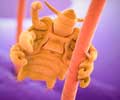Parents and school nurses take note. Lice are a familiar nuisance around the world and vectors of serious diseases, such as epidemic typhus, in developing regions.

In this study, scientists from of the University of Queensland and the J. Craig Venter Institute found that in stark contrast to the single circular mitochondrial chromosome typical of most animals, the human body louse has evolved a set of 18 "minichromosomes." While multiple mitochondrial minichromosomes have been previously described in plants and protists, this is the first report of an animal adopting a highly fragmented mtDNA structure.
The group also looked at mtDNA structure in other sucking lice, including human head and pubic lice, as well as sucking lice that infest other primates, and found that the mtDNA of these lice is also fragmented. Interestingly, they report that "chewing lice," closely related lice that feed on the hair or feathers of other animals, do not have fragmented mtDNA chromosomes, suggesting that multiple minichromosomes may have coevolved with blood feeding.
Dr. David Rand of Brown University, a mitochondrial DNA evolution expert, said this exciting discovery raises new questions in the field. "Why is it restricted to this lineage? Why don't we see transitional stages of this organization in related lice?" Rand also asked whether fragmented minichromosomes has implications for gene regulation. "Does this organization provide an advantage for more control over individual gene expression in mitochondrial genomes?"
Rand noted that this work and the intriguing questions raised will motivate researchers to take advantage of new technologies to investigate the mtDNA structure of other animals. "As new sequencing tools allow researchers to move away from single-gene studies to whole genome analyses of mtDNA, we may see that the sucking lice story is more common than we expected."
Source-Eurekalert
SRM










